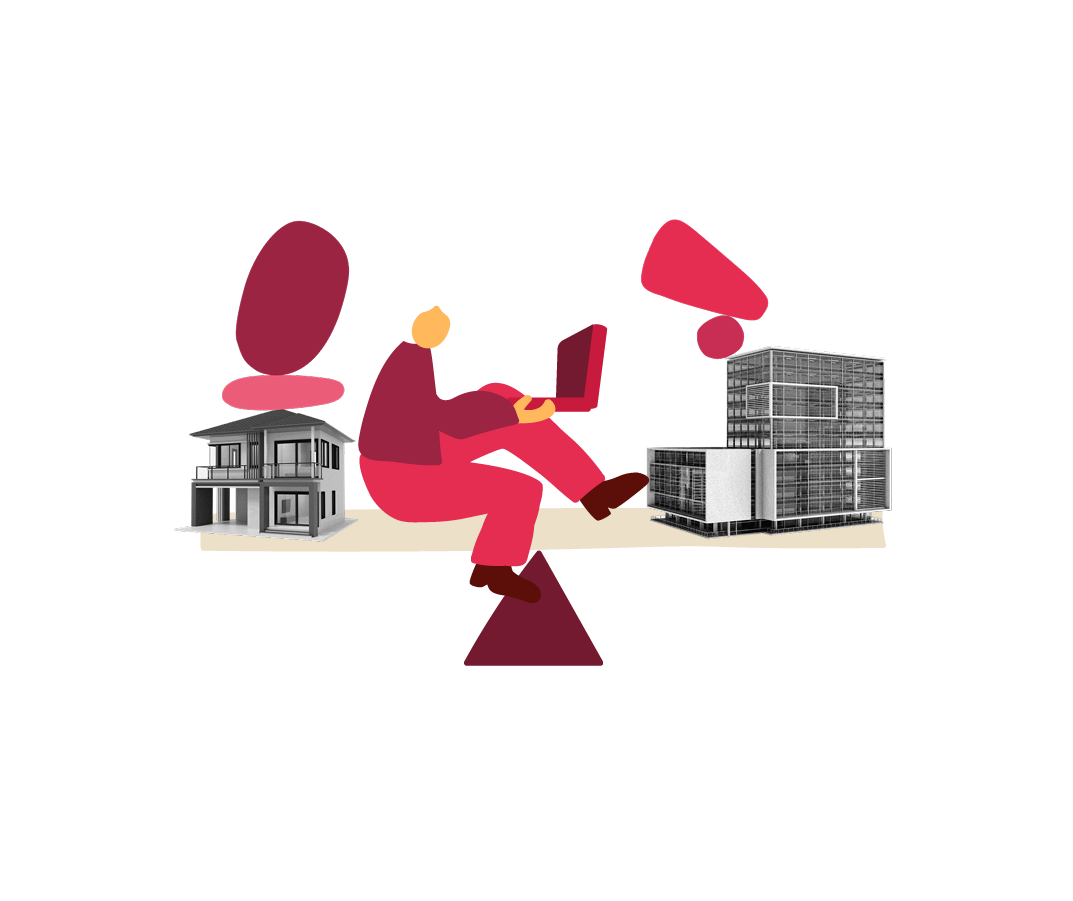Introduction
In 2020, the top concern of HR leaders around the world was how to transition their workforce to a remote operation. The pandemic’s dire circumstances forced us to quickly rethink how and where work gets done. Individual contributors, managers, teams, and leaders all had to make significant adjustments, including shifting to remote and hybrid work structures.
The question for businesses now is how do we facilitate a positive return to the office? Although going back to work in person is often referred to as “return to work,” make no mistake: People have been working productively regardless of their location. Whether working from kitchen tables, home offices, or neighborhood coffee houses, they get work done. Many don’t feel the need to leave home to accomplish the same goals.
Post-pandemic, numerous companies boldly declared return-to-the-office policies but walked them back when their people vehemently protested. Past surveys, like McKinsey’s, from January 2021, indicated that many people would switch jobs if required to return to work entirely on-site. Many companies backed off their initial plans to return to the office during the Great Resignation. Instead, they expanded remote and hybrid work.
Now, 76 percent of the Fortune 100 use a hybrid schedule. And that arrangement is likely to increase for organizations of all sizes. Companies that allowed fully remote work during the pandemic have become increasingly vocal about people coming back in person, either on a full or hybrid schedule. Recent ResumeBuilder.com research found that 66 percent of companies in the United States require people to work from the office and that 90 percent will require a full return to the office in 2023.
While a return to work is inevitable for most people, there are mixed emotions around this process for many. Studies show that executives are more eager to return to the office than employees: Nearly half of executives prefer to work from the office daily, but just 17 percent of employees surveyed shared this excitement.
Plus, data also shows a real generational clash with Baby Boomers demonstrating a weaker appetite than Millennials and Gen Z for hybrid work. In fact, 37 percent of people over 50 years old are likely to be found in the office five days a week, as opposed to just 20 percent of under-35s. Flexible work models within a company—whether around hybrid, remote, WFH, or WFA—are now highly sought-after by younger professionals, too—more so than any other workplace condition.
For now, the number of people returning to the office continues to increase. However, the average is still below pre-pandemic figures—although the Partnership for New York City predicts an imminent tipping point.
Plus, given the economic climate, the impending threat of recession, and extensive layoffs by businesses across the globe, employers are gaining more leverage when it comes to making demands. This has caused people who were entirely resistant to returning to the office to consider changing their perspective.
Instead, we see that people are going back to working on-site and want the interaction that takes place there—just not full-time. In fact, a 2022 AT&T study suggests that remote work will decrease from 56 percent in 2021 to 19 percent in 2024, but hybrid work will grow from 42 percent to 81 percent over the same period.
Whether the majority of people end up returning to the office full- or part-time, it’s still important to make coming into the office a positive experience. But how? There is still a great deal of uncertainty about what work life will look like.
As more employers learn how to navigate the unchartered waters of hybrid working, some companies now offer incentives to entice their people back to the office.
The challenges of managing a return to the office
After two years of working from home, today’s professionals are likely to consider a day in the office as an added expense—and rising costs are only making it worse. Some companies are considerate of their people’s concerns and now offer practical solutions aimed at alleviating costs related to in-office days.
Media company Bloomberg is offering its US staff a $75 daily commuting stipend. In the UK, consultancy firm PwC is giving commuters an extra £1,000 to come into the office. Bank Goldman Sachs is offering free breakfast and lunch to their people.
Other incentives include revived and refreshed office spaces. Many companies are redefining what WFO looks like in an effort to encourage their people back in, build culture, and create exciting, engaging spaces.

Return to office considerations for Gen Z and Millennials
COVID served as a catalyst for people to rethink their priorities in the workplace, lining up more and more with the ideals of Gen Z and Millennials. The two youngest generations in the workforce place an emphasis on the personalization of work relationships and a fundamental and ongoing reliance on technology. What does this mean in the office?
Both generations are similar in their approach to work but have slightly different preferences. Both enjoy in-person collaboration but equally value the flexibility that working from home affords. Millennials often prefer to use on-site days for meetings and collaborative brainstorming while executing the work itself at home, without the distraction of other people.
Gen Z prefers more on-site time to look for mentorships and people they can learn from on the job. However, both generations enjoy the option of flexibility and being able to work from anywhere—when they want—to get the job done.
Flexibility is key here. Hybrid work allows employers to rethink where their people perform their best work. In today’s modern world, a team is likely to be made up of introverts, extroverts, creatives, and many others—and all of these people will have a different way of working most efficiently.
For example, there may be someone doing a job that requires concentration. For them, a quiet environment works best. A requirement to come into a noisy office will hinder their productivity.
Plus, flexibility is a crucial part of DEI&B strategy. Managers need to be aware of how changes in work location can adversely affect marginalized groups, such as people with disabilities, single parents or those with young children, or minorities who live far away from the office. When devising a return-to-the-office policy, it’s important for companies to consider how to maintain their commitments to diversity and inclusion. They risk losing out on top talent if they don’t.
The role of managers in returning to the office
Employers worldwide have new territory to navigate when considering how to get back to working in person when people resist. One particular challenge is the need to manage teams in a new and modern way.
Many employers manage a globally dispersed, hybrid workforce where some people come to the office for in-person meetings, and others dial in remotely. In other cases, managers conduct the majority of interactions with their team members via instant messaging platforms, such as Slack, in an effort to be more efficient.
In these situations, it is vital that managers receive training in how to communicate confidently over different kinds of media. All too often, people can misinterpret the tone of someone’s voice over digital platforms, even when the intent is entirely innocuous. Managers can better preserve cohesion and avoid tension between team members when they know how to handle incidents like these. Maintaining these internal professional relationships is vital for management. It is critical to rebuilding in-office company culture and modes of communication.
In short, organizations must be flexible and ready to respond to challenges as employees and employers learn what matters most during these transitory times.

5 steps to take when planning a return to the office
Planning a return to working on-site can be a challenge. Use these five steps to help ensure you have an intelligent plan.
1. Assess your people’s sentiment about coming back to the office
There are many theories and projections about how people will react to return-to-office mandates. Research shows that 64 percent of professionals would consider quitting if asked to return to the office full-time. Yet other reports suggest that people miss the camaraderie of an office and long to have some in-person connections with their colleagues. Only your employees can tell you what’s true for them.
The first step in your return-to-office plan should involve sending a survey to assess your people’s opinions. Surveys help you keep your finger on the pulse while allowing for confidentiality. Include open-ended questions to encourage more open and nuanced communication in addition to the Likert scale and multiple-choice questions that will help you gather a general idea of what could work best for your organization.
The survey should cover topics such as:
- Experiences with remote work
- Processes and communications your teams need
- Individual preferences for returning to the office
- Health and safety practices required for comfort in the workplace
If you want a turn-key back-to-office work survey, check out our 19 thoroughly tested survey questions you can use for your company.
2. Adopt flexible work options for good
To survive the pandemic, organizations had to adopt flexible work options. Even leaders who place great value on “facetime” realized that many successful work practices do not require people to be on-site. Some industries, roles, or operations may not be able to adopt a fully remote model, but don’t let that stop you from considering creative, flexible work options.
Companies that embrace flexible work options demonstrate they trust their people to do their jobs even when not being watched. The organization benefits when that trust develops from the C-level down through managers and employees. Trust the data on productivity and resist the instinct to micromanage individuals and teams, especially when they are not in sight.
American Express is an example of a company that has embraced a creative approach in its flexible work options. They allow people—including those working hybrid, entirely virtually, and fully on-site—to work up to four weeks a year away from their primary worksite.
“Ultimately, our goal is to achieve the best of both worlds—recapturing the creativity, connections, collaboration, and relationship building of working together in person, while also retaining the flexibility and progress we have made together in this virtual world,” said their CEO in Amex Flex—Our New Way Of Working.
Consider flexible work options
If you’re looking for a way to attract and retain talent, it’s important to consider how you can offer flexible work options. Without flexible options, your organization could be at risk of losing top talent. In a tight labor market and during economic downturns, HR professionals play a crucial role in helping employers attract and retain talent.
Devjani Mishra of Littler told HR Executive that existing employees will be raising requests for flexible work options, and job applicants will ask about the same during the interview process. Rey Ramirez, co-founder of Thrive HR Consulting, estimates that companies miss out on 50 to 70 percent of candidates when they don’t offer flexible work options.
Companies that adapt and embrace flexibility are demonstrating that they’re listening to today’s professionals—and they’re better off for it.

“A whopping 76 percent of employees say they want their company to make work permanently flexible, for example, when it comes to things like schedule or location,” according to The Great Work/Life Divide report.
As the BBC reports, there’s no one right answer for what flexible work looks like. What works for one company may not work for another. Business needs for the return to working on-site will vary depending on sector, size, and structure. What’s essential is that each organization tries to think creatively about how to make work more flexible. Recent conversations about mental health, work-life balance, and burnout only emphasize the need for a new way of working.
3. Continue your use of technology
We have seen a dramatic shift in people using tech to help them communicate from remote locations. Slack, MS Teams, project management tools, and HR tech tools have helped employees and managers maintain communications and retain a sense of organizational norms. As a result of being remote, companies have also started thinking of digital ways to innovate the employee experience.
“We’ve used Miro, for example—a virtual whiteboard solution—to brainstorm ideas and capture thoughts and feedback,” a brand and event manager told the BBC. “To maintain our company culture, we’ve also had to become very creative over Slack—we’ve had Paddlers create custom music videos, and we’ve paid to have Cameos [personalized videos made by celebrities] done for us to celebrate big milestones.”
Investment in tech attracts talent
As more companies push for a return to the office, now is not the time to ignore the digital strides you’ve made. As you plan for and adopt an approach to returning to work in person, keep using the tools that worked well, and continue to train your people to develop a skills-based workforce.
The lack of tech skills is partially responsible for the massive skills gap and war for talent. Technology is essential in today’s multi-national, digital world, but it advances in the blink of an eye. Ensuring your workforce is trained to keep up is simply good business practice.
Whether people are working in the office or at home, it’s crucial to have a plan to upskill them into new and critical technologies and ways of working. This investment can save money in the short and long term. After all, it’s less expensive and less time-consuming to invest in training the talented workforce you already have than it is to embark on a lengthy and expensive recruitment effort.
4. Prepare for changes due to time away
Whether it’s after a pandemic or leave of absence, people must adjust when they return to the office. During their time, no doubt, some things have changed.
In the post-pandemic world, perhaps meetings are held in larger conference rooms with better ventilation, or people who don’t feel well are encouraged to stay home. Clearly communicate any changes in procedures and explain the reasons behind them. This transparency will build trust and reinforce that the changes are designed to help them.
As part of your plan to welcome people back to the office, don’t forget the elements related to personal interactions. After time away, those personal connections can be some of the most challenging for people to navigate when they return.
“People with even a hint of social anxiety or shyness before the pandemic have generally not been troubled by staying home and working remotely—and may feel relieved not to deal with in-person interactions,” Margaret Wehrenberg, psychologist and author of “Pandemic Anxiety: Fear, Stress, and Loss in Traumatic Times,” told CNBC Make It. “Going back to their environment will be very hard,” she says.
Prioritizing employee wellbeing through changing times
Employee morale must be a top priority when people return to the office. After a significant in-person absence, people may be struggling with a sense of disconnection and even disengagement. They may struggle with new demands or desire to maintain flexibility between work and home life. Don’t forget that some people coming to the office may have been hired remotely and never met or worked with their colleagues in person.
Preparation is critical for these challenges—ensure that you have programs and policies, such as flexible work options, mental health benefits, and team-building activities to support your people.
To help your people navigate a return after time away, also look at your communication approach. If you’re switching to a hybrid work model from a fully remote one, what parameters do you have in place for how people communicate with each other? Similarly, in what ways will you reinforce collaboration and ensure everyone has the tools they need to partner? Finally, if the return to on-site work follows tumultuous times, consider what team-building methods you might be able to use to build trust within the “new” work environment.

5. Get ready for new challenges that come with a new work environment
As people return to in-office work, they may face bumps in the road as they adjust to the new environment.
Before issuing a return-to-the-office order, consider what coming back will look like. People may work differently and have different needs.
The role of office design in the new world of work
For example, the office function may need to shift, so it is primarily for collaborative and communication activities or events that are hard to coordinate remotely. The physical set-up of the office and the amenities it provides may need to change. If people must commute to the office, they expect to get something from the trip they couldn’t get if they were at home. For example, people do not favor coming to the office for a Zoom call that they could have attended remotely.
When staff comes into the office, where will they work? With people working remotely, companies have decreased and redesigned their office spaces to support collaboration and productivity. This might mean fewer desks and seats. Some companies may use “hot desks” or require people to reserve a seat for themselves on days when they’ll be working in person. Without these protocols, people may make fruitless trips to the office with nowhere to sit and work.
When considering office design, it’s important to look at how the space works for the incoming staff. Not everyone works best in a noisy office environment. Companies should rethink where and how people work best. Creatives, introverts, and others doing jobs that require lots of concentration may work better in a quiet atmosphere. That could be at home or the office, but if the office is noisy, mandating office attendance can impact productivity.
Speaking of potential noise levels: Teams will need to re-learn how to communicate internally when some may be in the office frequently while others work remotely (or from different sites). How do you ensure communication is frequent and consistent?
Leaders must communicate over different mediums, but messages can come across negatively in an email versus during an impromptu chat in the office hallway. Managers and HR must be trained to handle these types of interactions to preserve team cohesion and avoid tension between team members.
Keeping DE&I at the forefront
Companies are asking even those on hybrid schedules to come into the office more frequently, but even as they make this push, they should also recognize that flexibility is part of a strong DE&I strategy. Understanding that sacrificing flexibility can cost you significantly in talent is critical.
Changes in work location can adversely affect marginalized groups. For example, if working on-site is mandatory, some great talent living far from the office may no longer be able to meet their commitments to new company policies. Returning to the office reduces caregivers’ flexibility in balancing work and personal responsibilities. This may affect women at a greater rate, and when striving for this balance becomes too difficult, they may drop out of the workforce.
Organizations should consider how to make the back-to-office transition easier and more sustainable. In addition to flexibility, family-friendly benefits can support people in balancing work and home life.

Keys to a smart return-to-office plan
It’s not enough to tackle these five critical topics. How you build your return-to-office-work plan is just as essential. For a successful return, your organization must be transparent, encourage employee input, and respect the needs of your entire workforce.
Adopt a transparent approach
In the past, it may have been acceptable to simply state the next steps. But after so much uncertainty in recent years, people want as much information as possible.
“Workplace transparency is proven to breed long-term success,” according to Glassdoor. “Implemented properly, increased transparency creates trust between employers and employees, helps improve morale, lowers job-related stress … while increasing employee happiness and boosting performance. And being transparent costs nothing, which gives it an exceptional ROI.”
As you make decisions about returning to the office, adopt a transparent approach. Share the what, as well as the why, behind company decisions. There’s no need to over-communicate, but with a few simple explanations, you can reassure people and help them understand your rationale. Even if they disagree, they will have the information they need to move forward.

Request your people’s input—and listen to what they say
As you plan a return to on-site work, it’s critical to reach out to your workforce and ask for feedback.
“There is an enormous disconnect between what employees and employers want,” a global head of marketing told Forbes. “The vast majority of people surveyed currently working remotely do not want to return to physical offices, but their employers are going to ask or mandate that they do.”
Important information and insights arise when you ask the people on the frontline. Be sure to take in their feedback without being defensive. Recognize that their perception is valid, even if it differs from yours.
You may only be able to meet some requests or make some desired changes. However, something as simple as asking for input shows you’re doing your best to make the return to the office a positive and comfortable experience.
Trust people who have proven their abilities
As you receive the input, trust those who have demonstrated they can be productive when working independently. In other words, resist the urge to micromanage. You may feel that by keeping a close eye on your reports’ activities, you can ensure they perform well. But the opposite is true.
Micromanaging decreases productivity and inhibits creativity. One of the reasons people state they are hesitant to return to the office is for fear their manager will want to look over their shoulder constantly.
Give team members who complete their assignments well and on time wider breadth and flexibility. This will allow them to get the work done where and how they’re most productive. Instead of spending time closely supervising someone doing great work, take a step (or two) back and provide support and encouragement when needed.
Respect the perspectives of your entire workforce
Every organization has its own nuanced workforce characteristics. Whether those characteristics come from job roles, generations, geographic location, worksite type, or all of the above, your return-to-office plan needs to respect and address each perspective.
“By engaging in a dialogue with employees, leaders can gain valuable insight about their concerns and challenges, establish trust, foster engagement and build a stronger sense of community,” said Patrick Hyland, Ph.D., Director of Research and Development at Mercer, an HR and benefits consultancy.
It’s common for leaders to not fully understand the day-to-day realities of a job because they’re not in the employees’ shoes. A successful return to the office for the entire organization depends on understanding the perspectives of individuals on every team.
A project manager may feel excited about a hybrid work opportunity. At the same time, an administrative assistant may be concerned about duplicative work in setting up meetings for in-person and online audiences. Look for the common denominators in employee experiences and the unique identifiers to ensure your plans represent as many perspectives as possible.

Recommended For Further Reading
Conclusion
Only some organizations will reinvent how work gets done as part of their return-to-office strategy, but the workplace of the future needs to be flexible. We’ve learned to WFH, WFO, and WFA—and we may still need to shift between these in the future—but people now have the experience and technology to adjust to changes, ensuring that wherever they are, work can get done.
Meanwhile, HR leaders can drive culture, two-way communication, engagement, performance, and compensation—all while streamlining and automating their processes. While it may feel like a huge hurdle to envision a new model, stay focused on the great benefits to productivity and employee wellbeing a return-to-office plan can support.

Meet Bob
At HiBob, we’ve built a modern HR platform designed for modern business needs—today and beyond.
We focused on building something that is robust yet intuitive and easy-to-use, which has led Bob to be the platform of choice for thousands of fast-growing modern, mid-sized organizations.
For HR, it delivers automation of many common processes, allows greater oversight and visibility of the business, and centralizes all people data in a secure, user-friendly environment.
For managers, it provides access to data and insights to help them lead more effectively and streamline processes.
For employees, it’s the tools and information they need to connect, develop, and grow throughout their journey.
